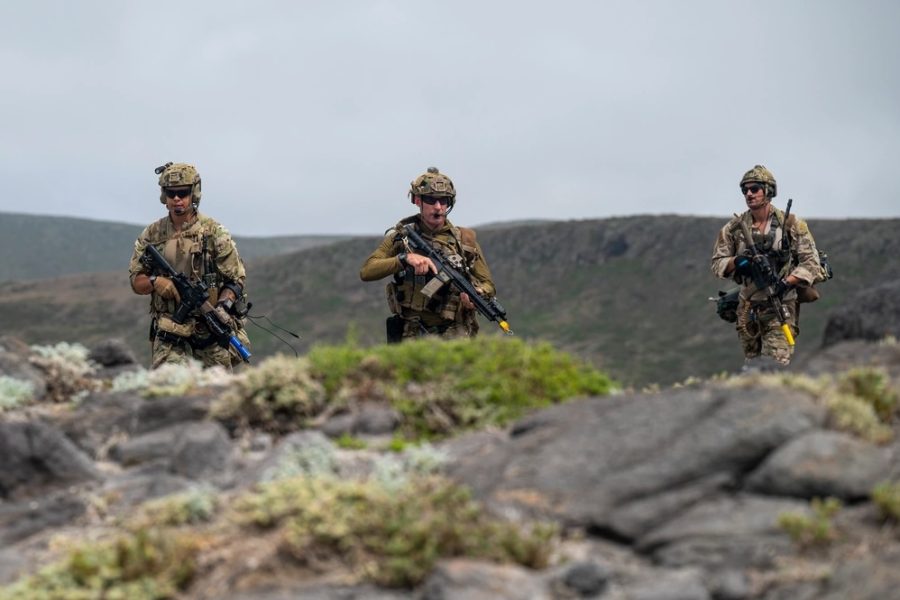In a recent exercise off the coast of San Diego, Calif., Air Force Pararescuemen (PJs) practiced caring for injured patients amid missile strikes, maritime contested airspace, limited supplies, and other challenges meant to simulate what they may face in a war against a near-peer adversary like China in the Pacific.
The three-day exercise, which involved parachute jumps, air-dropped Zodiac boats, U.S. Navy helicopters, resupply airdrops, and patients with bloody make-up, was even more impressive considering that it was put together by a squadron located 400 miles away at Davis-Monthan Air Force Base, Ariz.
“The Combat Leader Course is a seven-week course of instruction that is a hybrid between a leadership course and simulated exercise,” Master Sgt. Trevor Runyan, the Instructor Flight Chief at the 68th Rescue Squadron, a Formal Training Unit (FTU) for PJs, told Air & Space Forces Magazine.
“That’s one thing that’s extremely unique about us as an FTU,” he added. “While there are organizations trying to innovate these concepts, we are actively employing them.”
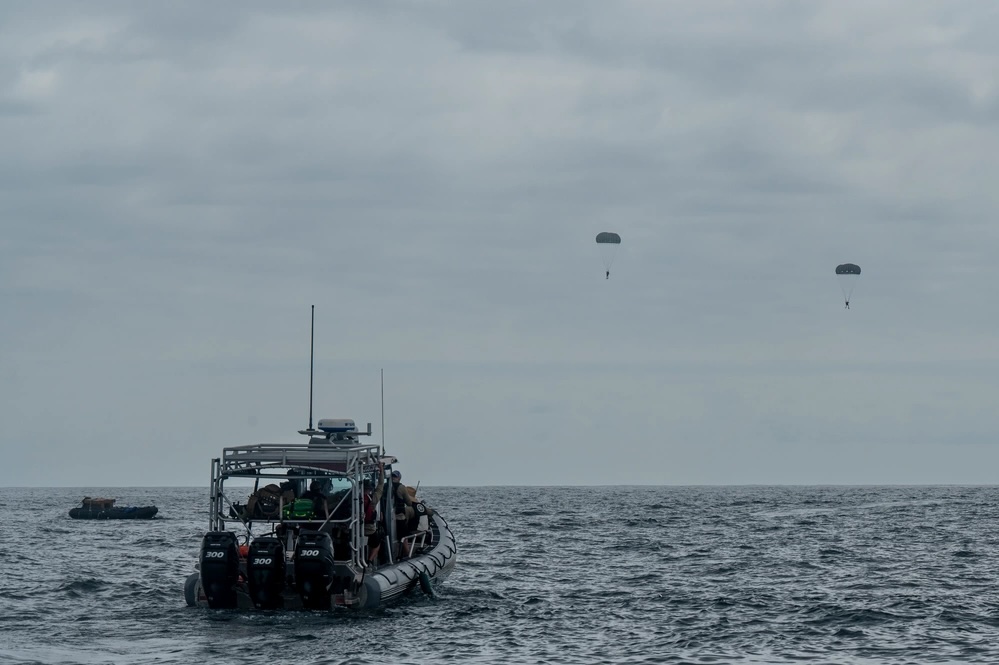
‘Grind and give it everything’
It takes nearly two years to train a PJ, but even when they finish their last day of the Pararescue Apprentice Course at Kirtland Air Force Base, N.M., a new maroon beret recipient has one more stop before arriving at an operational squadron: the 68th RQS. Dubbed the ‘Guardian Angel FTU,’ the squadron hosts a two-month Combat Team Member Course that brings new PJs through Mission Qualification Training required for deployments and a majority of the Journeyman skill level (a.k.a. ‘5 level’).
Before the 68 RQS stood up in 2014, PJ squadrons around the world each ran internal training, duplicating effort, Runyan said. The FTU fixes that problem, but it takes work.
“The 68 RQS is relied upon as one of the only hubs for the entire career field,” he said. “With that, we get a lot of pressure and demand.”
Besides the Combat Team Member Course, the squadron also runs the Air Force’s only Military Freefall Jumpmaster Course, and the Combat Leader Course (CLC), where PJs with about 6-10 years of experience attend to become PJ team leaders. Just four instructors are dedicated to teaching the CLC, which currently prepares leaders for operating in an INDOPACOM environment. This means organizing complex exercises like the one off the coast of San Diego.
“The culture here has been to grind and give it everything you have,” Runyan said. “The challenge with CLC is balancing planning, logistics, running operations and providing instruction to the students. We can always use more resources and manning to provide the highest level of instruction to the students.”
Targeted
The Air Force as a whole is embracing a strategy called Agile Combat Employment, where Airmen proactively and reactively maneuver for both strategic and tactical advantage. This can mean operating from small airfields on islands across the Pacific, a major change from the sprawling air bases in Iraq and Afghanistan during the Global War on Terror.
To practice agility, the 68 RQS sent CLC students from the simulated ‘main operating base’ at Davis-Monthan to a forward operating site (FOS) near San Diego on short notice with deliberate limitations placed on equipment and personnel. The PJs parachuted into the Pacific with Zodiac boats and boarded a small ship that had been hit by a simulated missile. Once aboard, the PJs provided prolonged field care to the patients aboard.
“It is a priority to practice prolonged field care following a mass casualty in a near-peer conflict,” Runyan said. “We train to conserve resources in order to limit our logistical footprint and improve patient outcome, especially when casualty evacuation is not readily accessible.”
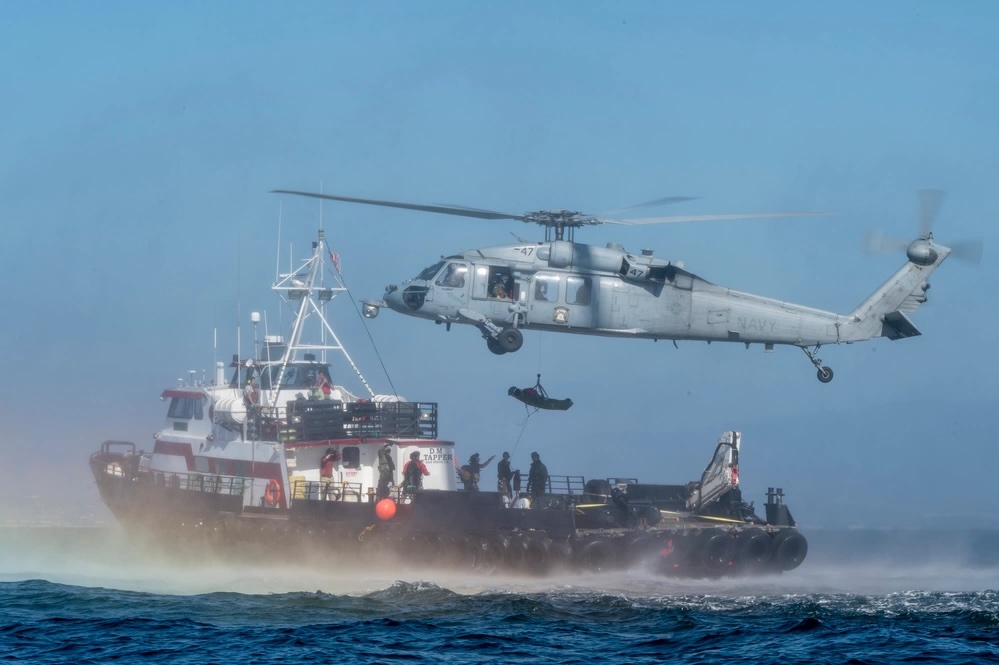
Every detail of the operation requires extensive planning. Freefall parachutes deteriorate if left in salt water too long, so the CLC instructors formed a plan for recovering them, transporting them to San Diego, and driving them back to Davis-Monthan to be rinsed and hung in a drying tower within 48 hours.
“In a real-world mission, you would sink the chutes,” Runyan said. “But losing 10 rigs in a training environment would cost the unit about $300,000.”
Each parachute weighed about 200 pounds when filled with salt water, so the team needed a rope system just to hoist the sodden material onto shoreside loading docks. Besides the parachutes, the squadron also had to move food and equipment for about 50 people (40 support staff and 10 students) out to San Clemente Island, located off the coast of San Diego, for the exercise.
While complicated, the ship rescue drill was just the start of the CLC’s time at San Clemente Island. The course’s culminating exercise kicked off Sept. 17 with a simulated missile strike on the students’ position near the island’s airfield. The students had five minutes to scramble and find shelter, then had to search for survivors in a mock town used for urban warfare training on the island. It was another mass casualty event, with about two dozen patients in need of treatment. The students dealt with collapsed structures, fires, and attacks by simulated opposition forces.
“This simulates one of the most likely mission sets we could respond to: mass casualties caused by a missile strike at a forward operating site,” Runyan said.
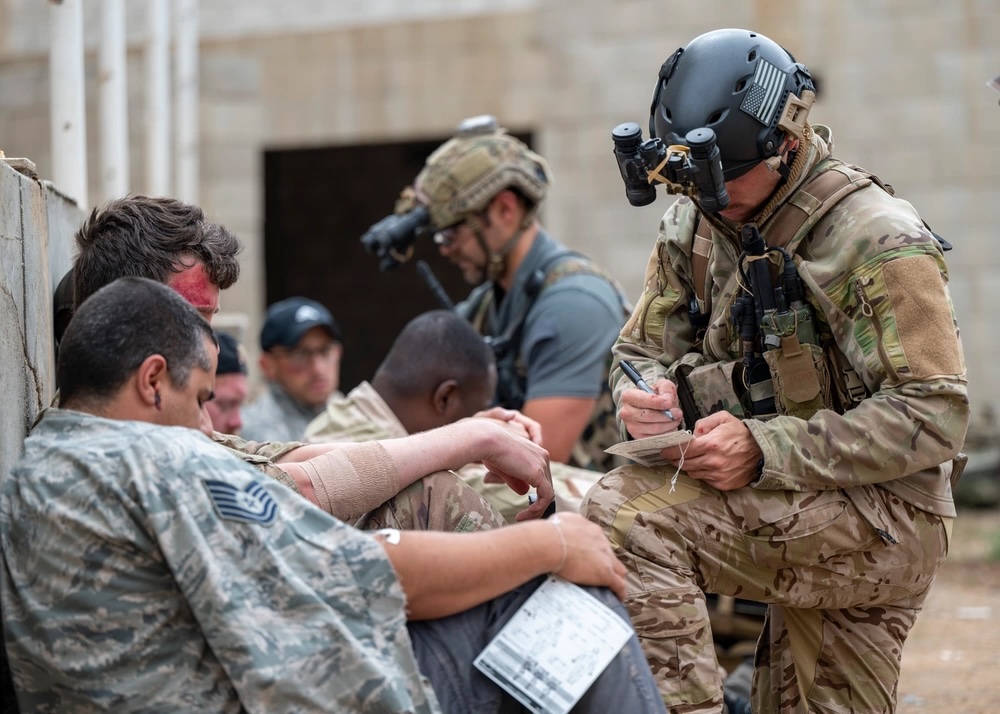
Joint Integration
Since the airfield had been targeted, the students boarded helicopters to move their patients to safety at another island, or, in this case, a cluster of shipping containers halfway down San Clemente that was simulated as a separate island. Once they arrived at the contingency location, the students continued to care for their patients while arranging for a resupply airdrop and planning for their next mission: rescuing multiple isolated personnel in a contested maritime environment.
“As a 10-man element, they must prioritize missions and determine if and when they should operate as a split team, and the risks associated with that,” Runyan said.
Joint operations were key, as two MH-60 Sea Hawks from the Navy’s Helicopter Sea Combat-23 (HSC-23) squadron flew out to San Clemente for two nights to rescue simulated downed pilots out of the water, while a third helicopter ran resupply missions.
“It is extremely beneficial for the students to integrate with joint DOD assets such as HSC-23,” Runyan said. “Integration between the PJs, HSC-23 crews and maintainers in an austere environment provided invaluable training for all involved.”
Some of the downed pilots were mannequins, while most were live role players. The PJs received the last known location of the downed pilots, then had to track their location 12 hours later by calculating tides, current, and wind speed. The PJs found that a few pilots had drifted into uncontested airspace within range of a helicopter, but most were still within contested airspace, where helicopters could not fly without risk of being shot down.
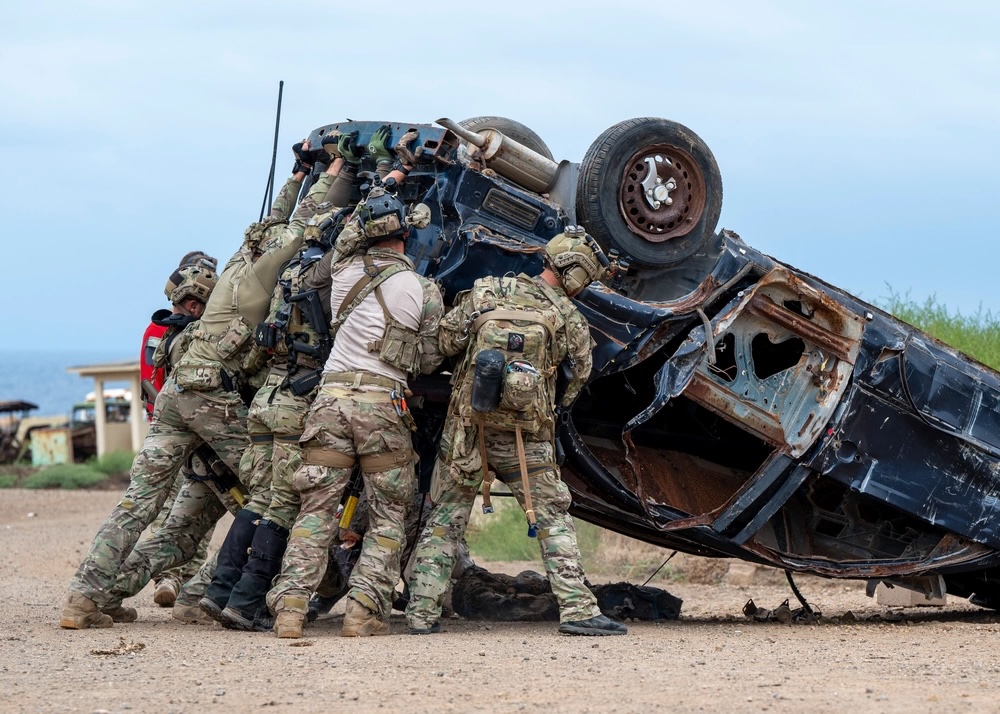
To reach those pilots, the PJs had to jump out of fixed-wing aircraft with parachute-configured Zodiac boats to enter contested airspace. One at a time, they found the pilots and ferried them back to uncontested waters, where they were rescued by helicopter or rendezvoused with a blue force maritime vessel. The helicopters flew them back to the contingency location on San Clemente Island, where the PJs administered prolonged field care until the helicopters could fly patients to an airfield for fixed-wing evacuation.
The Puck
New technology helped make the exercise much more realistic. In the past, when operating in areas without cell service such as San Clemente Island, instructors might pass information over a radio or give them verbal injects. But at this exercise, the instructors and students carried small, puck-shaped devices that let them share texts, location, and other information through their smartphones.
Made by Somewear Labs, the pucks used the Iridium satellite constellation to send short bursts of data, which are more difficult for adversaries to jam or listen in on. The tech meant exercise participants could immediately communicate and visualize each other’s locations, which made command and control on the remote island much easier.
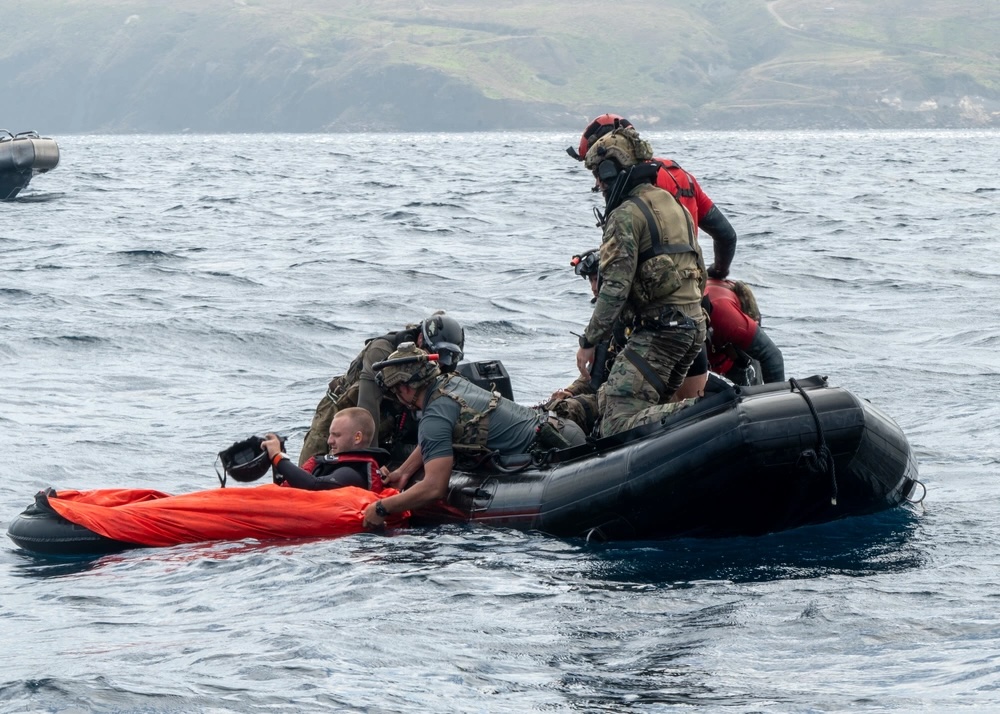
“All communication was sent with either the Somewear pucks or through HF radio,” Runyan said. “It let the students exercise decentralized command, enabling them to act on mission-type orders and execute on commander’s intent and previously agreed upon risk acceptance.”
The pucks also put the ‘search’ back in ‘search and rescue.’ Usually during ocean drills, instructors hover near simulated downed pilots in a large safety boat, which keeps the exercise safe for human role players but also makes the survivor easier for students to spot. At this exercise, the instructors still stayed close for human role players, but they also sent mannequins adrift in one-man life rafts, using the Somewear pucks to keep track of the ‘pilots’ even when they were out of sight.
It was a massive effort to plan, but the culminating exercise for the CLC involved realistic scenarios that many Air Force officials anticipate in a near-peer conflict. Now for the 68 RQS, it’s back to the drawing board for the next class.
